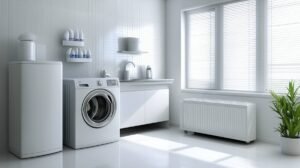Energy-Efficient Appliances
Adding energy-efficient gadgets to your home is a smart move for cutting down on those power bills. Let’s chat about why ENERGY STAR appliances deserve a place in your home and how they help with monthly costs.
Why Pick ENERGY STAR Appliances?
Choosing ENERGY STAR certified appliances means you’re picking efficiency without losing the good stuff—like top-notch performance and durability. They comply with the energy-saving standards put forth by the EPA, making them an excellent choice for folks who care about the planet and smart spending.
Here’s the lineup of some ENERGY STAR champs:
- Dishwashers
- Fridges
- Washing Machines
- Ceiling Fans
- Ventilation Fans
Switching to these can mean less energy use and a smaller carbon footprint. Notably, ENERGY STAR clothes dryers use 20% less energy, and their heat pump versions get you savings up to 60%.
Lowering Your Bills
Investing in ENERGY STAR appliances means you don’t just save the environment—you save money, too. Their efficiency in water and energy use can slice your bills considerably. Replace those old energy guzzlers and see the difference when the bills roll in.
Check out these savings:
| Appliance | Energy Savings (%) | Annual Savings ($) |
|---|---|---|
| Clothes Dryer | 20-60% | $100 – $300 |
| Dishwasher | 12% | $20 – $30 |
| Refrigerator | 15% | $50 – $70 |
| Washing Machine | 25% | $60 – $80 |
These are based on typical home usage and costs.
Using these kinds of appliances in every room bumps up your home’s efficiency. For example, ENERGY STAR fridges have to meet standards that require them to use at least 15% less energy than basic models.
Apart from new appliances, think about other ways to save, like:
- Lowering the thermostat saves around 3% per degree when it’s chilly outside.
- Cutting water heater temps to 120 degrees can shave off 3-5% on those heating costs for every 10-degree drop.
With savvy upgrades, like smart tech and energy-saving gadgets every little bit adds up. Programmable thermostats and LED lights are other small changes that help your home’s energy plan shine.
For more cool tips on saving energy, check out our rundown on smart lighting and managing home temps.
Cooling and Heating Efficiency
There are clever tricks to save energy right at home. Swapping your old cooling and heating systems for more efficient ones can really slash your energy use and cut costs.
High-Efficiency Air Conditioners
High-efficiency air conditioners get the job done without guzzling power, giving you cool air without the guilt. As per Energy.gov, switching to these smart units can chop down your air conditioning energy use by up to half! That’s a fab pick for folks wanting to lower their monthly bills while keeping things eco-friendly.
| Type of Air Conditioner | Energy Savings |
|---|---|
| Standard Air Conditioner | Your usual use |
| High-Efficiency Air Conditioner | Slash it by up to 50% |
When picking a top-notch air conditioner, here’s what to peek at:
- ENERGY STAR Certification: This badge tells you it meets tough energy guidelines.
- SEER Rating: The Seasonal Energy Efficiency Ratio—the higher, the better!
- Variable Speed Motors: Keeps the cool just right, making your system work smarter.
Got your curiosity piqued about energy-efficient gadgets? Check out our segment on awesome appliances.
Benefits of Heat Pumps
Another neat trick for sprucing up home heating and chilling is the spiffy heat pump. These bad boys can trim down heating power use by about 65% over those old-school electric heaters (Energy.gov). And they deliver toasty warmth when it’s chilly and soothing cool when it’s hot. Double-duty, anyone?
| Heating System | Energy Savings |
|---|---|
| Electric Resistance Heating | Your usual use |
| Heat Pump | Over half slashed, up to 65% |
Why fall for heat pumps? Here are a few reasons:
- Energy Efficiency: Move heat around instead of creating it—a real saver!
- Comfort: Keeping things comfy all year long with heating and cooling.
- Eco-Friendly: A smaller carbon footstep compared to old-school heaters.
Hunting for more tips? Dive into our articles on cool tech and smarter home upgrades.
By tossing in high-efficiency air conditioners and heat pumps, you can cut energy waste and bask in a greener, happier home. For a treasure trove of energy-saving tactics, swing by our energy conservation techniques section.
Efficient Lighting Choices
Changing up your home’s lighting game can save a bundle and help Mother Earth. Two word-of-mouth tips? LED lights and energy-efficient bulbs.
LED Lighting Savings
Ever heard of LEDs? They’re kinda the MVPs of the lighting scene, gobbling up way less power than those old-school incandescent bulbs. To put numbers on it, LEDs sip about 90% less juice and last 25 times longer. For the person keeping an eye on utility bills, these bulbs are a no-brainer.
With an LED switcheroo, your home could pocket around $225 yearly on energy bills. That’s no pocket change! Plus, they strut their stuff in all sorts of styles, colors, and spots—inside or outside. They’re champs in the cold too!
| Lighting Type | Energy Use | Lifespan | Annual Savings |
|---|---|---|---|
| Incandescent Bulbs | 100% | ~1,000 hours | $0 |
| LED Bulbs | 10% | ~25,000 hours | ~$225 |
Data from Energy.gov
Think about pairing LEDs with timers and dimmers. Timers cut the lights when no one’s around, and dimmers let you choose the mood, cutting electricity costs in the process.
For those outdoor lights out past curfew, try LEDs or Compact Fluorescent Lamps (CFLs). Fixtures with an ENERGY STAR nod often come with neat extras like sun-sensing shut-offs and motion sensors.
Switching to Energy-Efficient Bulbs
Tired of those electricity-hogging incandescent bulbs? Try out LEDs or CFLs for a quick win in cutting energy bills. Plus, the price tag on LEDs has taken a nosedive and looks set to dive further.
Energy-efficient bulbs like LEDs and CFLs guzzle way less power compared to the old glow sticks from the past. Take a peek at this:
| Bulb Type | Energy Consumption | Lifespan (Hours) |
|---|---|---|
| Incandescent | 100W | 1,000 |
| CFL | 25W | 8,000 |
| LED | 10W | 25,000 |
Data from Energy.gov
When you’re set to flip the switch, check if your new lights get along with your existing fixtures and controls. Dimmers and timers can seriously amp up energy savings, making sure lights only shine when needed (Energy.gov).
Want to know more about slashing energy use at home? Dive into our article on energy conservation techniques and scope out more tips like energy-efficient home upgrades.
Temperature Control Strategies
If you’re trying to keep your energy bills from looking like they’ve been on steroids, mastering your home’s temperature control is a smart move. A good thermostat can be your best friend in this battle. This section dives into why those snazzy programmable thermostats are worth the hype and how you can set them up like a pro.
Programmable Thermostat Benefits
Programmable thermostats aren’t just a gadget for control freaks; they’re your ticket to dialing down those energy hog bills. They let you schedule your heating and cooling without lifting more than a finger, and they can make your wallet noticeably happier.
- Energy Savings: According to the folks at Energy.gov, if you drop your thermostat by 7°-10°F for 8 hours a day, you might shave up to 10% off your yearly heating and cooling expenses. This trick works wonders if you live somewhere with mild weather.
- Optimal Winter Settings: Aim for 68°F to 70°F when you’re hanging out at home in the winter. The money-saving fairy visits if you lower it when you’re catching Zs or out and about (Energy.gov).
- Summer Efficiency: In summer, think about a balmy house when you’re not home, and dial it up a tad when you are because sweat is free, while energy isn’t (Energy.gov).
- Avoid Excessive Cooling: Cranking your AC to the max doesn’t cool faster and is just a waste of juice. So be gentle on that dial.
Setting Thermostat Guidelines
Here’s a cheat sheet for thermostat settings that’ll help you keep your home cozy without playing thermostat tug-of-war.
| Season | Time of Day | Recommended Setting |
|---|---|---|
| Winter | Awake | 68°F – 70°F |
| Winter | Asleep or Away | Cooler than daytime |
| Summer | Away | Warmer, keep the sweat glands idle |
| Summer | Home | Slightly uncomfortable luxury |
- Winter Days: When Jack Frost is nipping, stay toasty at 68°F to 70°F. When you’re not home or in dreamland, drop it to let your heater rest while your bills chill (Energy.gov).
- Summer Days: Greet your AC with kindness; set it higher when the house is empty, and ease it down when you return to the lap of comfort (Energy.gov).
- Avoid Rapid Cooling: The AC’s not a caffeinated sprinter; fiddling with settings frantically doesn’t help anyone, least of all your wallet.
Contrary to popular belief, a furnace or AC isn’t busting a gut to reclaim a cozy temp after a setback. Your house actually loses energy slower when the mercury dips. So, you end up winning in the energy-saving game.
For more money-saving nuggets, check out articles on energy-saving products and energy-efficient home upgrades. Also, take a peek at various energy-saving programs available to savvy homeowners like yourself.






